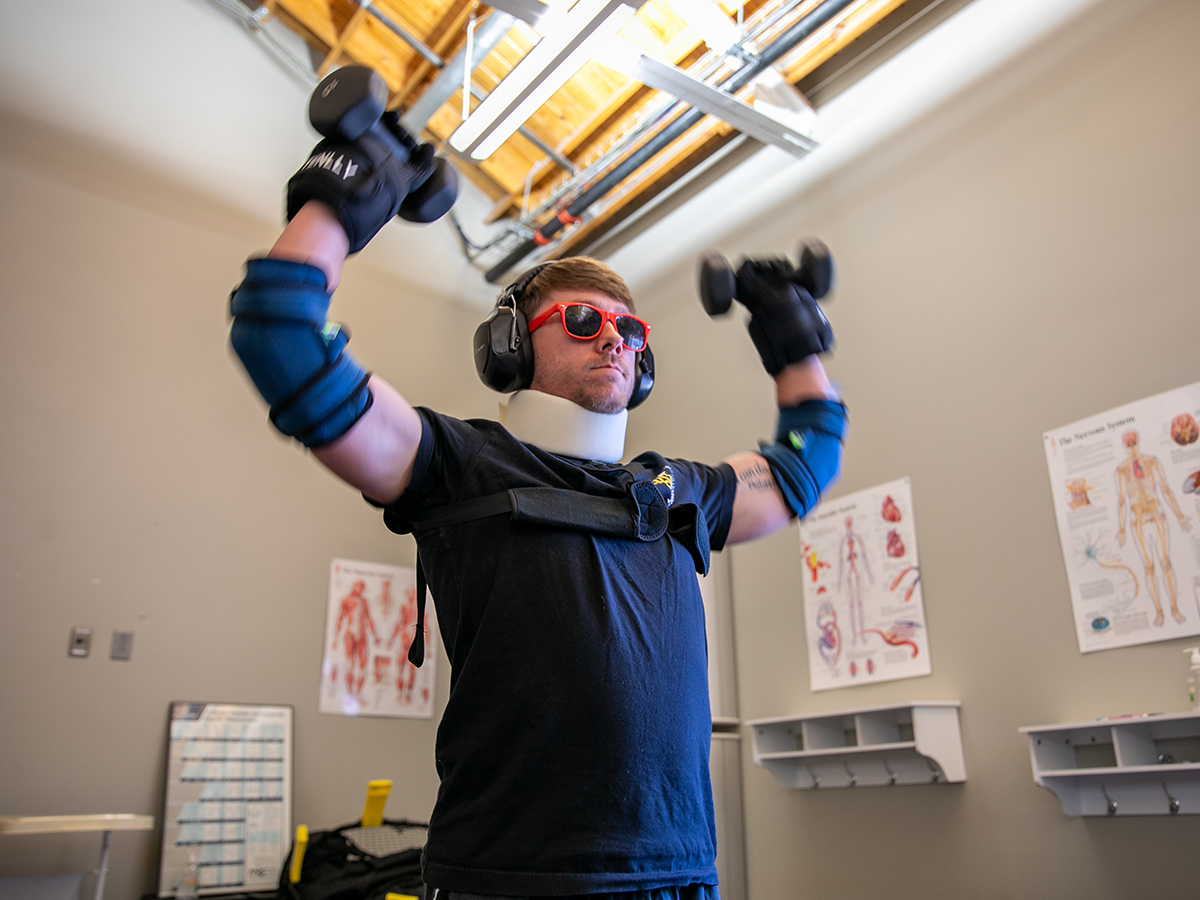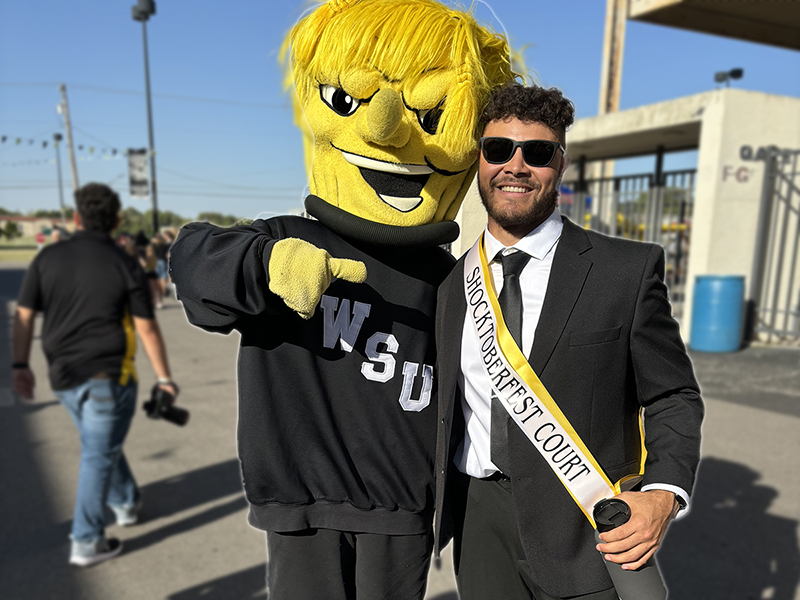When Wichita State University physical therapy students strapped on sunglasses smeared with petroleum jelly, ankle weights and a stiff neck collar, the laughter came quickly. They shuffled around the room, testing their balance in flip-flops to mimic neuropathy and difficulty with walking, while leaning on friends as they struggled through simple tasks.
But as the exercises wore on, the fun gave way to frustration. Hearing became muffled under earmuffs. Vision blurred. Knees stiffened. Students who had just been joking about their new look began to feel something else: the physical and social isolation many older adults live with every day.
That shift — from amusement to awareness — is exactly what Dr. Justin Smith, assistant professor and board-certified geriatric clinical specialist, hoped for when he built a homemade geriatric-simulation suit and launched a pilot study to measure its effect on empathy in physical therapy students.
From Hollywood to the classroom
The idea struck Smith after watching “Limitless,” a National Geographic series featuring actor Chris Hemsworth. In one episode, Hemsworth dons an “aging suit” designed by researchers at Massachusetts Institute of Technology to better understand the physical toll of growing older.
“These suits cost $2,500 to $3,000,” Smith said. “From there, the research idea took shape: Could I design a homemade version, and how might using it impact empathy in our students?”
He got to work. His version runs about $250–$300 and includes everything from cataract-simulating sunglasses to wrist and ankle weights to simulate age related weakness from sarcopenia.
Empathy in motion
Smith and his students put the suit to the test in a pilot study, recently published in Gerontology & Geriatrics Education. Thirty-eight physical therapy students completed standard performance tasks — such as sitting, standing, walking and balance exercises — first without the suit and then while wearing it.
The difference was dramatic. Students in their 20s suddenly performed like healthy adults in their 70s.
“I had no idea. It gave me a new sense of empathy for older adults,” one student reflected in a post-experience paper.
Still, when measured using the Jefferson Scale of Empathy, the results were modest. Empathy levels increased, but not enough to reach statistical significance. Smith points to the small sample size as a likely factor and is already expanding the project to 100 students in his next research study.
Student experience
For students, the suit offered a rare chance to blend science with lived experience.
“It was a challenging but rewarding process,” said Mason Engleken, a third-year physical therapy student from Sabetha, Kansas, who helped organize data collection and present findings. “Research like this matters because it shows us where we stand before we’re out in the field. If we can adjust the curriculum to strengthen empathy, that makes us better clinicians.”
Adam Rutherford, a third-year student from Coffeyville, Kansas, and coauthor on the study, agrees.
“Empathy plays a critical role in physical therapy, especially with older adults who may be dealing with loss of independence,” he said. “Projects like this give educators feedback so we can continue to strengthen the human side of therapy, not just the technical side.”
Jace Merritt, another third-year student, believes this type of research makes for better physical therapists.
“Empathy directly impacts patient outcomes,” he said. “By understanding the challenges older adults face, student PTs can develop greater compassion and improve their communication, treatment planning, and overall quality of care.
Beyond the suit
Smith’s vision extends beyond a single 30-minute exercise. This year, his class will also add a dementia simulation and pregnancy simulation, giving students a wider lens on the challenges faced across populations.
And while the suit may not guarantee statistically significant shifts in empathy scores, it does something harder to quantify in that it sparks reflection.
“Many students said the hearing and vision impairments made them feel isolated, like they couldn’t connect with the world,” Smith said. “That sense of loneliness mirrors what many older adults actually feel, which may be one of the most eye-opening outcomes.”
By partnering with Larksfield Place, an independent living community in Wichita, Smith’s students also interact with older adults directly, taking the empathy they built in class into real-world relationships.
A cost-effective tool with lasting impact
Commercial geriatric suits may be sleek, but Smith’s low-budget version proves that empathy-building doesn’t require expensive equipment. For a fraction of the cost, WSU students are getting hands-on lessons in compassion alongside clinical skills.
“It’s hot, it’s tiring and it makes the simplest tasks frustrating,” Smith said. “But if even one student walks away with a deeper understanding of what their future patients live with, it’s worth it.”
About Wichita State University
Wichita State University is Kansas' only urban public research university, enrolling more than 23,000 students between its main campus and the WSU Campus of Applied Sciences and Technology (WSU Tech), including students from every state in the U.S. and more than 100 countries. Wichita State and WSU Tech are recognized for being student-centered and innovation-driven.
Located in the largest city in the state with one of the highest concentrations in the United States of jobs involving science, technology, engineering and math (STEM), Wichita State University provides uniquely distinctive and innovative pathways of applied learning, applied research and career opportunities for all of our students. The National Science Foundation ranked WSU No. 1 in the nation for aerospace engineering R&D, No. 2 for industry-funded engineering R&D and No. 8 overall for engineering R&D.
The Innovation Campus, which is a physical extension of the Wichita State University main campus, is one of the nation’s largest and fastest-growing research/innovation parks, encompassing over 120 acres and is home to a number of global companies and organizations.
Follow Wichita State on social media:






